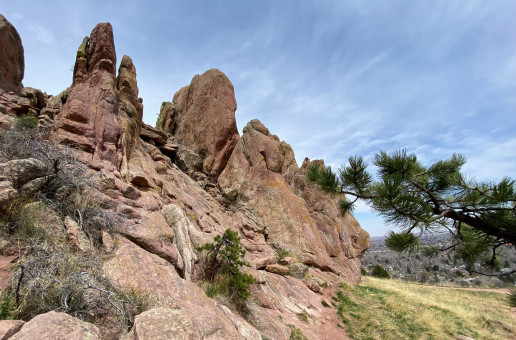Boulder's Indigenous History
The Boulder area encompasses ancestral homelands of Indigenous people who were here for thousands of years before white settlement. We welcome you to learn more about the area's first inhabitants through the resources below.
Visit Boulder acknowledges that the land on which we live, work and recreate today has been inhabited by Indigenous people for more than 13,000 years. We honor all Native nations associated with the Boulder Valley, affirm their ancestral ties to their homeland and acknowledge the history of mistreatment and forced removal that has had a devastating impact on their communities. When we discuss Boulder with visitors and our communities, we are discussing Native lands, and we endeavor to do our part to include the stories of the area’s first inhabitants.
Recent Archaeological Discoveries
In 2008, a landscaper in Boulder stumbled upon a collection of 83 Clovis-era tools, now known as the Mahaffy Cache, providing evidence that people lived in the Boulder Valley area much earlier than previously acknowledged. Laboratory analysis revealed that the tools contained proteins of camels, horses, bear, sheep and megafauna that roamed Colorado 13,000 years ago. The tools are on permanent display at the University of Colorado Museum of Natural History.
Two other sites in Boulder County offer evidence of early Indigenous people in the area. The Rock Creek site (near Boulder west of Hwy. 287) shows evidence of fire pits, stone tools, bone tools and ceramic remains dating to 5500-3300 B.C. and A.D. 1-1550. At a second site, called Zaharias (near Hwy. 128 west of McCaslin Blvd.), researchers found evidence of game processing dating back 470-2,000 years.
Boulder's Indigenous Tribes
Nearly 50 different Native American tribes were in and out of Colorado throughout history, according to Ernest House, Jr., a member of the Ute Mountain Ute tribe and former executive director of the Colorado Commission on Indian Affairs. The Arapaho and the Utes are the two tribes most associated with Boulder’s recent past.
Ute territory spanned all of Colorado for hundreds of years before white settlement. They acquired horses from the Spanish around the 1600s and were among the first native people to have horses in significant numbers. Utes controlled the Colorado mountains and camped in teepees as they hunted buffalo and other game and collected fruits and berries.
The Ute people retreated to the mountains west of Boulder after the Arapaho, an enemy tribe, moved into the Boulder Valley, most likely having migrated from the Great Lakes region to the central plains sometime in the 1600s.
The Southern Arapaho bands favored the Boulder Valley for the winter months. They also acquired horses, camped in teepees, hunted game and gathered edible plants. Known as gentle people, they also earned a reputation for their savvy business and trade practices.
Fred Mosqueda, a Southern Arapaho tribal historian and Sand Creek descendant, explains that the Gros Ventre people may well have been in the Boulder area as well, before being ravaged by smallpox and migrating north.
Many place names in Boulder County reflect the indigenous history of the area. The town of Niwot, Ute Highway, Chipeta Park, Arapaho Glacier, the Arapaho Peaks, Arapahoe Avenue, Neva Road, Left Hand Canyon, Left Hand Creek and many more significant sites reflect the tribes and their homeland.
White Settlement
In the late fall of 1858, a party of Nebraska gold prospectors camped at Boulder Creek, near the Red Rocks formation. They encountered Chief Niwot (Left Hand), the leader of the Southern band of Arapaho, who astonished them with greetings in their own language. Niwot was fluent in English because his sister had married a white trader who taught him the language.
Niwot informed the group that they were on Indian land. The 1851 Treaty of Fort Laramie, also called the Horse Creek Treaty, had granted a large section of land between the Arkansas River and the North Platte, including today’s Colorado Front Range, to the Plains Indians. The settlers told Niwot that they planned to go into the mountains to search for gold the following spring. Niwot allowed them to camp temporarily through the winter.
In January of 1859, gold was discovered at a stream called Gold Run near today’s Gold Hill. The settlers abandoned their promise to Niwot and platted the Boulder City Town Company on February 10, 1859.
Though Niwot tried to find a way to get along, the newcomers overwhelmed the Arapaho, arriving by the thousands and taking over Indian land. “As you come here hunting for gold, then hunt after the gold and let the Indians alone,” Niwot said. His efforts to keep the peace were not successful. Tensions between native people and white settlers escalated.
A new treaty was signed in 1861, the year Colorado officially became a territory, reducing the Indian land to one-tenth the previous size. The treaty encouraged all peaceful Indians to make camps in a small, barren area in southern Colorado by the Big Sandy Creek. Those who relocated were promised protection and safety for their people. Niwot led his small band to the new reservation, joining Cheyenne people and other bands of Arapahos.

Looking east to Boulder's Red Rocks
The Sand Creek Massacre
Territorial Governor John Evans viewed the Indians as an impediment to progress, and he wanted them gone. In 1864, he received authorization from Washington, D.C., for a 100-day U.S. Cavalry and recruited soldiers to find and kill hostile Indians.
In August of 1864, nearly 100 Boulder County residents mobilized into Company D of the Third Colorado Cavalry of U.S. Army Volunteers at Fort Chambers (near 63rd and Valmont Streets) to become "Indian Fighters." They set off from Fort Chambers and made their way to a peaceful camp on the Big Sandy Creek (a site about 200 miles southeast of Boulder). Here, at the instruction of the American military, several Cheyenne and Arapahoe chiefs had settled about 750 of their people and received "day rations" as a means of keeping them there.
On November 29, 1864, under the command of Colonel John Chivington, an estimated 230 Arapaho and Cheyenne people were slaughtered by the First and Third Colorado Cavalry of U.S. Volunteers, which included about 675 federal troops. Two-thirds of those killed were women, children and the elderly. Chief Niwot was mortally wounded.
Captain David Nichols, a former Boulder County Sheriff, led Company D, including 46 Boulder residents, in the attack. The Boulder troops enjoyed a heroes’ welcome upon their return.
Although the nation was horrified by what came to be called the Sand Creek Massacre and a congressional inquiry took place, no one was punished for the murders.
After a series of subsequent treaties, the Northern Arapaho and Cheyenne tribes were forced to reservations in Wyoming and Montana, and Southern Arapahoe and Cheyenne people were relocated to Oklahoma. White settlers moved onto former Indian land in Colorado Territory and the Boulder Valley.

"The Sand Creek Massacre" by Robert Lindneaux
‘The Utes Must Go’
The fate of Colorado’s Ute people was tragic, as well. When gold prospectors arrived by the thousands to the Rocky Mountains, they encroached on Ute hunting grounds. As the settlers desired more land, the U.S. government negotiated an 1868 treaty whereby the Utes relinquished the central part of Colorado and agreed to inhabit only the western third of the state.
Still, tensions between white settlers and the Utes escalated. After multiple treaty violations intruded on their traditional way of life, the Utes fought back. In the 1879 Battle of Milk Creek, the White River Utes killed Nathan Meeker, a U.S. Indian Agency official, and 10 others after their racetrack was deliberately destroyed. In the aftermath of the Meeker Massacre, “The Utes Must Go” was an oft-repeated headline in newspapers.
In 1881, the Utes were forced from their homeland to reservations in southern Colorado and Utah. Traditional Ute lands were then fully open to white settlement.
Native American Rights Fund
In the 1960s and 1970s, many organizations formed to address the history of discrimination against underrepresented groups in the U.S. Boulder is home to one of the most respected of those, the Native American Rights Fund (NARF), founded in 1970. NARF is the largest nonprofit law firm dedicated to asserting and defending the rights of Indian tribes, organizations and individuals nationwide.
Acknowledging the Sand Creek Massacre
The Sand Creek Massacre National Historic Site was dedicated in 2007 and is operated by the National Park Service. The site is in Kiowa County, a four-hour drive from Boulder, and attracts visitors from all over the world who want to learn more about this tragic chapter of history. In 2014, on the 150th anniversary of the massacre, the state of Colorado, under Governor John Hickenlooper, issued a formal apology to the tribes.
Indigenous Peoples Day
Today, Boulder is home to people of many Indigenous nations. In 2016, the Boulder City Council unanimously designated Indigenous Peoples Day as the second Monday in October of each year. The City of Boulder sponsors programming on the holiday to promote knowledge, combat prejudice and eliminate discrimination against native people.
The City also has a number of ongoing efforts in partnership with tribal representatives to initiate meaningful action for our community.
The first stop at the museum's Experience Boulder Gallery is a wonderful video exhibition about Boulder's Indigenous people.
Read about the significance of this park, once known as Settlers Park, discover the meaning of its current name and plan a visit.
Creative Nations is a permanent on-site establishment for Indigenous artists at the Dairy Arts Center. Learn about exhibits, events and markets.
Take part in unique celebrations and events, happening each October in Boulder.
Evidence of an early Indigenous drive wall, a hunting wall used to trap game, can be seen on this trail.
See a collection of 80+ stone tools found in a Boulder backyard in 2008. The artifacts date to approximately 13,000 years ago.
This organization brings Native women together for adventure, exploration and celebration of the wilderness and their native lands.
You'll see many references to Chief Niwot (or Left Hand) in the Boulder area, including this sculpture beside Boulder Creek.
This mural, behind the Boulder Theater, depicts a red hand over a woman's mouth, the symbol of the Murdered and Missing Indigenous Women movement.
A sculpture in front of the Boulder County Courthouse is a symbolic rendering in tribute to the Arapaho by artists Steven Weitzman and Tara Brice.
A mural by Cante Eagle Horse on the exterior of the Dairy Arts Center depicts Native imagery and the message "Honor the Earth."
This mural at Rayback Collective features "Shoshone Pete," with a lightning bolt over his eye representative of David Bowie's Ziggy Stardust.

















